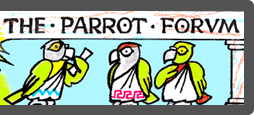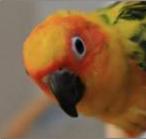I'd imagine when gliding, a bird would have learned to fly at the best L/D speed at which the net sum of parasitic drag and induced drag would be the minimum. I think a clipped parrot would have to either fly at a higher airspeed and/or a higher angle of attack in order to maintain lift in order to overcome the clip (I'm talking in terms of glide rather than flapping). I think their glide would be less effective but no more stressful.
Sustainable flight would obviously be significantly more difficult and climbs near impossible. This is because thrust is required to sustain or climb. I really have not seen clipped parrots fly or climb. They usually flap or glide down to the floor and land ASAP if they do takeoff. They really cannot fly far. One trick I sometimes see them do is fly in ground effect where drag is less and requires them less energy to sustain.
This really to me seems more like comparing a person with short legs vs someone with long legs for running. Both can run but the short person has to run harder to keep up with the long legs. The short person may give up the race sooner out of exhaustion from running too hard. I don't see the short person over-stressing their body over it but rather giving up sooner. The same thing happens with a clipped parrot. They don't try to fly for 5 minutes nonstop because they can't. They'll fly for 30 seconds at most which probably takes them the same amount of stress/energy as a flighted parrot did in 5 minutes.
Certainly the effects of clipping are under studied and the psychological effects are mostly speculative. If I can't find a scientific argument to let them fly, then it's just because it's fun to watch them fly and play with them in flight. They are birds. They came with wings. They should keep them that way. Simple as that.



The Parrot Pyramid
25 posts • Page 3 of 3 • 1, 2, 3
-

Michael - Macaw
- Gender:

- Posts: 6286
- Location: New York
- Number of Birds Owned: 3
- Types of Birds Owned: Senegal Parrot, Cape Parrot, Green-Winged Macaw
- Flight: Yes
Re: The Parrot Pyramid
Michael wrote:I'd imagine when gliding, a bird would have learned to fly at the best L/D speed at which the net sum of parasitic drag and induced drag would be the minimum. I think a clipped parrot would have to either fly at a higher airspeed and/or a higher angle of attack in order to maintain lift in order to overcome the clip (I'm talking in terms of glide rather than flapping). I think their glide would be less effective but no more stressful.
The thing about this is, parrots are not to made for gliding. This takes special proporties. They need the propultion(up and downward motion of the wings) for lift. So therefore it becomes really really inefficient for a clipped parrot to glide. Even a not clipped parrot coudlnt make use of groundeffect like birds who are made for gliding: They dont have to flap at all, with a breeze they just put their wings in the air and take off. This would need alot of headwind for a parrot to achieve. If u want to cut the wings of a parrot for glidingpurpose the amount of induced drag will increase more then the decrease of parasatic drag, therefore becomming relatively more ineffective then when not clipped.
I also think, no i see it at my worst flying bird, that he is flying with a high angle of attack. This will result in a forward movement of the pressurepoint(the point where the lift grabs on the wing, i dont know the english term). This means that the bird has to correct for this with a counter momentum, which will result in more drag.... There are alot of factors involved, and i wouldnt be surprised if i missed something.
All i can say is that a large heavy aircraft a few seconds prior to landing, in full landing configuration, a few knots before stallspeed with this high angle of attack, the pressure difference between the upper and lower section of a wing is huge. This means constant having a high induced drag. Without winglets this increases. In this configuration a clipped flying bird flies contantly. What effect this could have on a wing i dont quite know, but i wouldnt be surprised if it had an effect on the wings or bird. Unless studied carefull u cant say that it doenst have any effect on the bird.
Michael wrote:This really to me seems more like comparing a person with short legs vs someone with long legs for running. Both can run but the short person has to run harder to keep up with the long legs. The short person may give up the race sooner out of exhaustion from running too hard. I don't see the short person over-stressing their body over it but rather giving up sooner. The same thing happens with a clipped parrot. They don't try to fly for 5 minutes nonstop because they can't. They'll fly for 30 seconds at most which probably takes them the same amount of stress/energy as a flighted parrot did in 5 minutes.
U cant compare running with flying, there are more factors involved.
In this assumption u compare an efficient non clipped parrot the the inefficient clipped parrot.
Lets say we clip a bird 50% off its wingcapacity. A clipped parrot would need more energy i would guess in order to achieve the same then the same typeparrot, non clipped. Cause of its forward movement induced drag increases relatively more due to the lack of its winglets then the decrease of parasitic drag. If the non clipped bird can fly from a to b in 10 minutes, the 50% clipped bird would need not 5 but lets say 6 minutes in order to achieve the same.
And i dont even took in account the higher angle of attach resultion in forward momentum of the pressurepoint.
Here is where planes differ also from birds. As birds flap their wing their pressurepoint constanly changes due to this mechanical movement. It shifts from a point in front of the Center of Gravity, towards the CG and will then travel from the CG forward again till that forward point again, then travells back to the CG on the motion of its wingflap. The distance between CG and forward pressure point will increase if the bird is flying at a higher angle of attack. If the bird has to correct more, what he will need to do, he will makes more drag thus becomming more inefficient. A plane its pressurepoint can/will also change during flight, but not by the rhytm of it's wingflaps, and it may shift towards the CG, in cruiseflight the pressurepoint is always behind the CG. Thats why the horizontal tail has to produce the negative lift in order to maintain its momentum.
This means that the bird is, just like an aircraft, calibrated for a certain pressurepoint. Altering this forward or afterwards will result in ineffectiveness(drag).
We as humans just recently discoved the theory of flight, compared to birds. They are the real experts. By looking at them we have build our planes, and contanly are looking for ways to become more effective by looking at birds.
Like i said before, give me some time and i will do my homework on this subject.
But i truly believe that parrots do have fun in flying, just as young kids like to run around on a play yard. Maybe not all parrots, just like kids.
Flock off!!
-

PRD - Lovebird
- Gender:

- Posts: 37
- Number of Birds Owned: 3
- Types of Birds Owned: Green cheek conure
Brown throat conure
Sun conure - Flight: Yes
Re: The Parrot Pyramid
I discussed this matter on some dutch forums and i see that people oversee the factor caused by induced drag. I did some homework and this is my conclusion sofar:
http://s9.photobucket.com/albums/a61/Williamsryder/?action=view¤t=GeinduceerdeR.jpg
Judging by this graph of the total drag of a frequent flapping bird in flight i can say of a clipped bird that its graph will look different and will rise. How it will rise exactly i cant say, but the effect of the increased induced drag, caused by the change in aspect ratio of the wings and the increasement of wake vortexes, is greater then then the decreasement of parasatic drag. The slower the speed, the greater the difference as shown if the graph in my previous post. Parasatic drag is more a factor for fast moving jets, less of a factor at slow speeds like our birds. Also increasing of the wingflapfrequenty will contribute to more induced drag.
For a clipped flapping bird on a perch this means, depending of how much/fast he is flapping, he will develop lift, and will develop induced drag. As he is not flying the wings dont have to carry all the weight. However, cause he is developping lift, the wings will carry some weight. A non clipped bird would require less effort/fuel to develop the same lift under same circumstances, so clipped bird is working harder at that moment. So cause the wings dont carry all the weight the effects of this could be minimal
A clipped flying bird, which flies at a higher angle of attack and slower speed, will automatically fly somewhere left of the lowest point in the graph. His graph is already higher then of a non clipped bird, so his most effecient point is already more inefficient then of a clipped bird. Cause of the high angle of attack it needs to fly to overcome the extra induced drag he will have to fly slower, so he will end up somewhere left of this point and will actually always fly in a landing, or in an approach situation.
As the graph shows, the bird wants and need to fly in it's lowest point. At this speeds and angle of attach he is the most efficient. Flying slower and at a high angle of attack means he will require more power compared to a non clip bird. His most efficient point is not olny lower, but he can fly in that point, in fact he can fly where he want. The clipped bird can only do approach flight, this can be maintaining altitude in approach configuration but also gliding towards the runway in landingconfiguration.
Flying constant under these circumstances for an aircraft means flying with a constant high pressure difference between upper and lower area of the wings. Cause of the vortexes and different apect ratio the developed lift will leak at the wingends resulting in more power to maintain flight.
This increasement of induced drag means increasement of lift: the clipped bird has to develop more lift with less wingarea (and same other features) then the non clipped bird.
About the groundeffect: even though they cant use the groundeffect as birds designed to use groundeffect i am sure my sun conure knows what it is. If he is sitting in the kitchen he will sometimes dive towards the ground and will fly fast and close to the ground, and will pull up at the last moment. In order to maintain that same altitude that low to the ground he would have to counteract the increasement of lift. Im 100% sure that he feels the increasement of lift and decreasement of induced drag and he likes to play with it. I heared other people also telling me their good flying parrots will do this, the clipped ones wont do it. Logical, they dont have the confedence do dive down, they cant fly at that angle of attack, he can't pull up at the end...
http://s9.photobucket.com/albums/a61/Williamsryder/?action=view¤t=GeinduceerdeR.jpg
Judging by this graph of the total drag of a frequent flapping bird in flight i can say of a clipped bird that its graph will look different and will rise. How it will rise exactly i cant say, but the effect of the increased induced drag, caused by the change in aspect ratio of the wings and the increasement of wake vortexes, is greater then then the decreasement of parasatic drag. The slower the speed, the greater the difference as shown if the graph in my previous post. Parasatic drag is more a factor for fast moving jets, less of a factor at slow speeds like our birds. Also increasing of the wingflapfrequenty will contribute to more induced drag.
For a clipped flapping bird on a perch this means, depending of how much/fast he is flapping, he will develop lift, and will develop induced drag. As he is not flying the wings dont have to carry all the weight. However, cause he is developping lift, the wings will carry some weight. A non clipped bird would require less effort/fuel to develop the same lift under same circumstances, so clipped bird is working harder at that moment. So cause the wings dont carry all the weight the effects of this could be minimal
A clipped flying bird, which flies at a higher angle of attack and slower speed, will automatically fly somewhere left of the lowest point in the graph. His graph is already higher then of a non clipped bird, so his most effecient point is already more inefficient then of a clipped bird. Cause of the high angle of attack it needs to fly to overcome the extra induced drag he will have to fly slower, so he will end up somewhere left of this point and will actually always fly in a landing, or in an approach situation.
As the graph shows, the bird wants and need to fly in it's lowest point. At this speeds and angle of attach he is the most efficient. Flying slower and at a high angle of attack means he will require more power compared to a non clip bird. His most efficient point is not olny lower, but he can fly in that point, in fact he can fly where he want. The clipped bird can only do approach flight, this can be maintaining altitude in approach configuration but also gliding towards the runway in landingconfiguration.
Flying constant under these circumstances for an aircraft means flying with a constant high pressure difference between upper and lower area of the wings. Cause of the vortexes and different apect ratio the developed lift will leak at the wingends resulting in more power to maintain flight.
This increasement of induced drag means increasement of lift: the clipped bird has to develop more lift with less wingarea (and same other features) then the non clipped bird.
About the groundeffect: even though they cant use the groundeffect as birds designed to use groundeffect i am sure my sun conure knows what it is. If he is sitting in the kitchen he will sometimes dive towards the ground and will fly fast and close to the ground, and will pull up at the last moment. In order to maintain that same altitude that low to the ground he would have to counteract the increasement of lift. Im 100% sure that he feels the increasement of lift and decreasement of induced drag and he likes to play with it. I heared other people also telling me their good flying parrots will do this, the clipped ones wont do it. Logical, they dont have the confedence do dive down, they cant fly at that angle of attack, he can't pull up at the end...
Flock off!!
-

PRD - Lovebird
- Gender:

- Posts: 37
- Number of Birds Owned: 3
- Types of Birds Owned: Green cheek conure
Brown throat conure
Sun conure - Flight: Yes
Re: The Parrot Pyramid
PRD wrote:For a clipped flapping bird on a perch this means, depending of how much/fast he is flapping, he will develop lift, and will develop induced drag. As he is not flying the wings dont have to carry all the weight. However, cause he is developping lift, the wings will carry some weight.
No. This does not apply when the bird is on the perch and not in flight. Lift to drag ratios assume that there exists forward flight. When the parrot is clasping down to the perch with its feet and flapping, it is not creating much lift. Most of the lift is experienced by the secondary feathers as a result of forward flight. Primary wing feathers create thrust which makes forward speed which then allows for lift to be produced. When a parrot is perched and flapping, it cannot have forward motion so most of that flapping is only creating drag. This especially so because the primaries are clipped and the secondaries create lift through forward motion rather than flapping. Think of an airplane on the ground with the propeller producing power while the brakes are being held. There is little or no lift over the wing. It is the airplanes forward motion through air (relative wind) that is primarily responsible for lift.
I am sorry, I think you are fighting for a good cause but I believe with flawed arguments. I am a pilot. I hold ratings in both glider and airplane. I have studied airplanes extensively and birds to the extent that I can and I really do not see these arguments holding true for stationary flapping. In terms of clipped flight vs non-clipped flight. The whole point of the clip is to discourage flight so by making it difficult to get anywhere and possibly more painful to do so, the owner is inflicting learning through punishment and achieving their goal. People who clip their parrots want to punish them for trying to fly and that is what clipping does. I think the debate needs to be whether it is moral or not to clip and what byproduct health factors are at stake as the result of clipping rather than the aerodynamic of wing clipping. I have talked to people who clipped a parrot all its life and then stopped clipping it because it never tried to fly. That is what clipping is for so I think it is the broader concept that needs to be analyzed rather than a temporary byproduct of a parrot that is clipped learning not to fly.
As for ground effect, I have watched my clipped budgie fly nearly all the way across the room once down to ground effect when he could not have gone 1/4th as far at high level. He got scared or something and started flying hard but sank lower and lower as he went but once over the ground just zoomed across the floor while flapping. Ground effect greatly reduces drag which allows even the lower aspect ratio wing with little thrust to go a long way.
-

Michael - Macaw
- Gender:

- Posts: 6286
- Location: New York
- Number of Birds Owned: 3
- Types of Birds Owned: Senegal Parrot, Cape Parrot, Green-Winged Macaw
- Flight: Yes
Re: The Parrot Pyramid
My sun conure will sit on his perch, flap his wings real hard and will let loose of it's foot and rises in the air like a helicopter. The graph in my pervious post also clearly shows the bird developping drag at speed 0, which is induced drag caused by lift. Parasatic drag will increase as speed builds up.
He might have speec o, but the wings have speed, thus lift and drag.
Therefore i can't conclude otherwise that a flapping bird will develop lift. I have had my sun conure sitting on my finger once where he did the dame as on the perch. U could definately feel the bird creating lift.
As we dont know what influence clipping has on a bird u cant exclude it will result in some heathissues.
Thats how i think about it.
He might have speec o, but the wings have speed, thus lift and drag.
Therefore i can't conclude otherwise that a flapping bird will develop lift. I have had my sun conure sitting on my finger once where he did the dame as on the perch. U could definately feel the bird creating lift.
As we dont know what influence clipping has on a bird u cant exclude it will result in some heathissues.
Thats how i think about it.
Flock off!!
-

PRD - Lovebird
- Gender:

- Posts: 37
- Number of Birds Owned: 3
- Types of Birds Owned: Green cheek conure
Brown throat conure
Sun conure - Flight: Yes
25 posts • Page 3 of 3 • 1, 2, 3
Who is online
Users browsing this forum: No registered users and 36 guests

